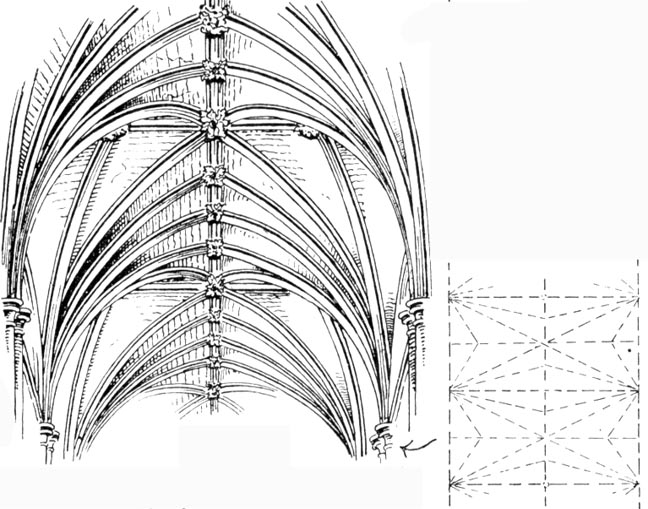
Early English groined vaulting with intermediate ribs, Westminster Abbey. Drawn by Banister Fletcher for A History of Architecture on the Comparative Method (5th ed), plate 112 (p. 285). Scanned image and text by George P. Landow (2007) [You may use this image without prior permission for any scholarly or educational purpose as long as you (1) credit the photographer and (2) link your document to this URL in a web document or cite the Victorian Web in a print one.]
Later in the thirteenth century intermediate ribs known as tiercerons, were introduced between the transverse and diagonal ribs as in the vaulting of the nave of Westminster Abbey, and were especially needed to strengthen the vaulting surfaces by decreasing the space between the ribs. In such cases ridge ribs were introduced in order to take the thrust of the tiercerons wdiich abut at their summit at an angle, and would have a tendency to fall towards the centre of the compartment unless resisted by the ridge rib. In continental examples the ridge rib is often not continuous, but only extends to the last pair of arches which abut against it obliquely. Ridge ribs are generally horizontnal in England and arched on the Continent, the "infilling " or "severy" having its courses meeting at the ridge in zigzag lines as in the nave of Westminster Abbey, and the naves and choirs of Lincoln, Exeter and Lichfield Cathedral, and as found in the churches of South-West France. — Banister Fletcher, p. 287
References
Fletcher, Banister, and Banister F. Fletcher. A History of Architecture on the Comparative Method for the Student, Craftsman, and Amateur. 5th ed. London: B. T. Batsford, 1905.
Last modified 30 August 2007